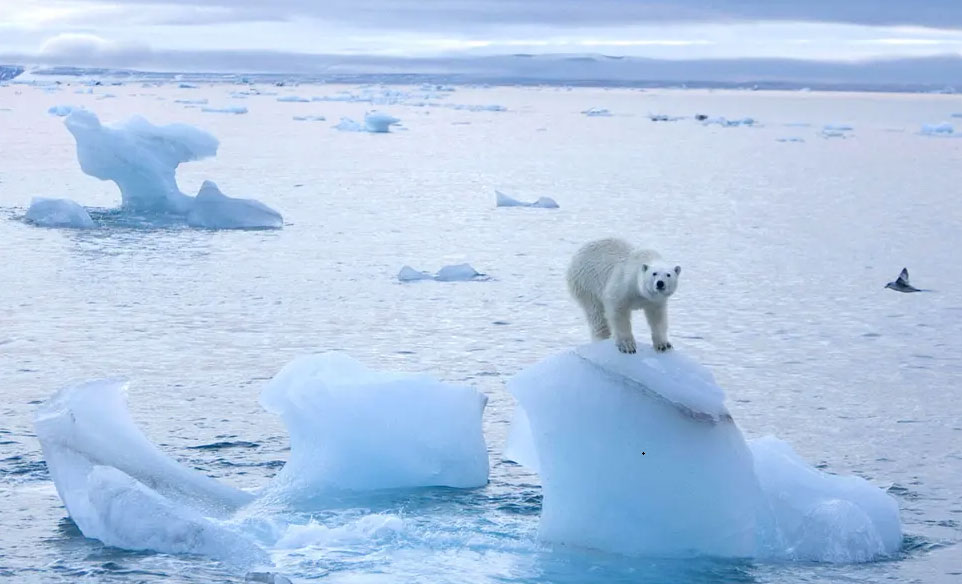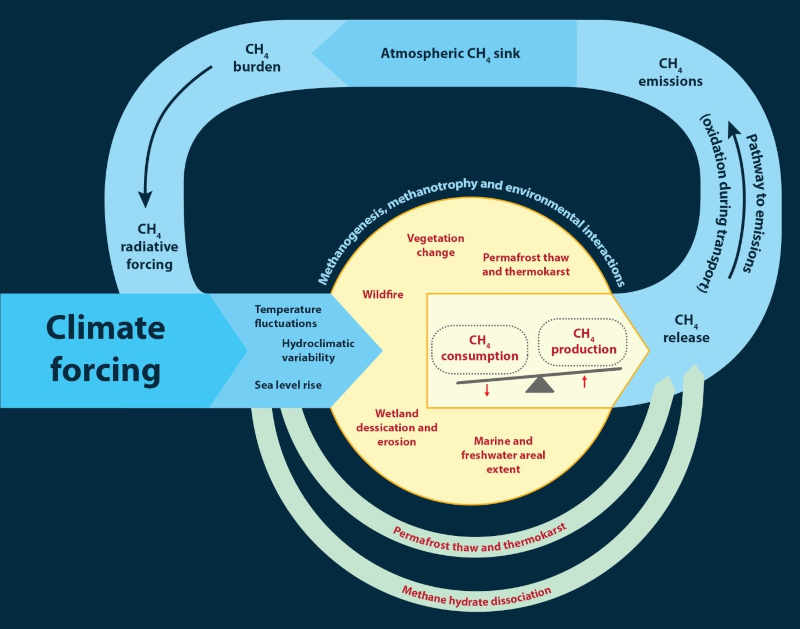What is Paleoclimatology? Why Should We Be Interested in it?
“Paleoclimatology is the study of changes in climate taken on the scale of the entire history of Earth. It uses a variety of proxy methods from the Earth and life sciences to obtain data previously preserved within things such as rocks, sediments, ice sheets, tree rings, corals, shells, and microfossils.”
We should be interested in Paleoclimatology because it is important for past, contemporary, and future issues. Understanding past climate helps us to explain how current ecosystems came to be. For example, climate typically controls what types of vegetation grow in a particular area.
We also understand from paleoclimate records, that the last time CO₂ levels reached 450 ppm was close to 3 million years ago, when camels roamed the Arctic. We know that 300 ppm and lower has been proven safe for humanity. Nothing higher has ever been shown to be survivable for modern humans in recorded history.
Furthermore, paleoclimatology provides data that we can use to model and predict both current and future climate change scenarios. Computer models can be used to study the potential effect of increased atmospheric carbon dioxide on climate and why ice ages occur as well as Hothouse Earths.
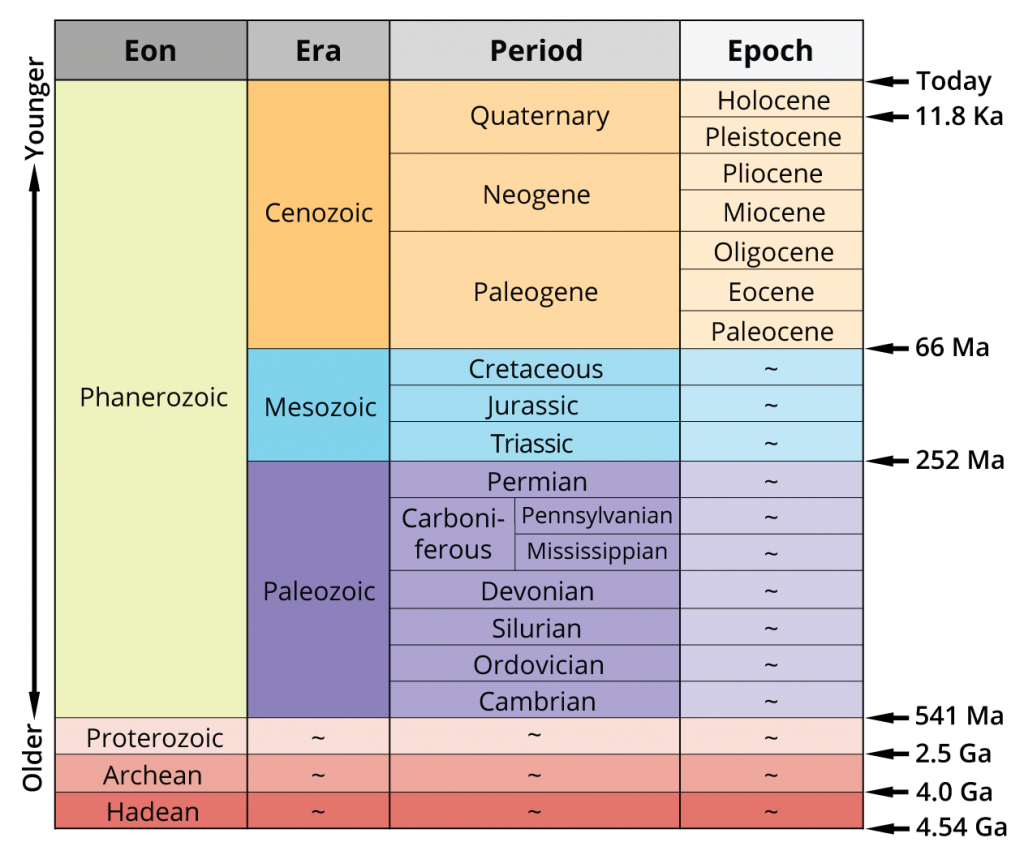 Understanding The Geological Time Scale and Associated Climate
Understanding The Geological Time Scale and Associated ClimateThe earth is approximately 4.6 billion years old. The image below illustrates the geological time scale which consists of Eons, Eras, Periods and Epochs. This video provides a good overview of the geological time scale.
The graph in this link provides an overview of how the climate, in terms of “Average Global Temperature” (AGT), has changed starting from around the beginning of the Cenozoic era.
How Do We Take Ancient Temperatures?
Temperature variations as well as concentrations of GHGs in the deep past are studied based primarily on analysis of ice cores—another type of proxy data. These ice cores not only record atmospheric temperatures through time, they also contain frozen bubbles that provide us with tiny samples of ancient air. Our longest ice core extends more than 800,000 years into the past. Ice Cores are archived at the National Ice Core Lab funded by the National Science Foundation. Ice Cores. ice has accumulated from snowfall over many millennia. Scientists drill through the deep ice to collect ice cores, which often have distinct layers in them.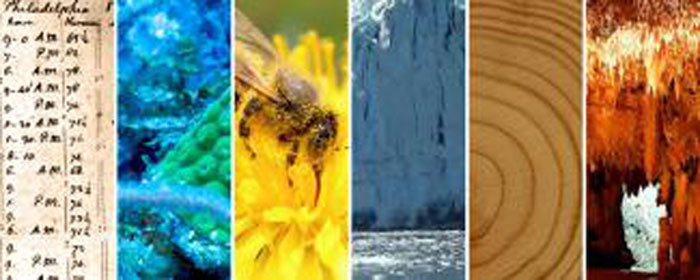
A Paleoclimatology Perspective on Climate Change
Peter D. Ward, Ph.D., is a paleontologist and professor of Geological Sciences at the University of Washington. He is also known as an extinction expert. Ward specializes in the Cretaceous-Tertiary extinction event (the one that killed the dinosaurs), the Permian-Triassic extinction event, and mass extinctions in general, going back millions of years. Ward has written many books including Under a Green Sky: Global Warming, the Mass Extinctions of the Past, and What They Can Tell Us About Our Future and The Flooded Earth: Our Future In a World Without Ice Caps. In the following video Ward introduces us to a paleoclimatology perspective on climate change:
Ward discusses the prior greenhouse gas extinctions in Earth’s long history and explains how they are analogous to what we are facing today. Generally, Ward says “when CO2 goes up, temperatures go up.” Historically, it is known that massive increases in CO2 emissions from volcanoes in the past have shifted the climate causing global mass extinctions. They also spewed ash, steam, and other gases and solids that impact climate as well. These waves of volcanism played a significant part in most of the 5 prior mass extinctions by significantly raising greenhouse gas (GHG) concentrations in the atmosphere. This along with other factors like solar activity and the modulation of the orbital parameters of the Earth are just some of the puzzle pieces that make up the big picture of ancient climate change.
In the most common climate change denial campaigns and stubbornly persistent climate myths, the claim is made that high levels of CO2 in the long past, somehow actually contradict the warming effect of CO2. However, this is simply not the case. In fact, significant items from the paleoclimate record are often missing from these debates. Michael E. Mann, Paleoclimatologist says “such a myopic view of weather extremes can be exploited by those who look to cast doubt on the overwhelming scientific consensus behind human-caused climate change.”
For example, it is known by paleoclimatologists that when CO2 levels were higher in the past, solar levels were much lower. The combined effect of sun and CO2 produces widely varying climates. Additionally, the Milankovitch Cycles are conveniently left out of these denier arguments, even though they govern how much of the sun’s energy reaches the earth. These cycles occur on such vast time scales that they are impossible to observe in a human lifetime and thus, easy to overlook. According to Skeptical Science on this matter:
“Atmospheric CO2 levels have reached spectacular values in the deep past, possibly topping over 5000 ppm in the late Ordovician around 440 million years ago. However, solar activity also falls as you go further back. In the early Phanerozoic, solar output was about 4% less than current levels. The combined net effect from CO2 and solar variations are shown in Figure 2. Periods of geographically widespread ice are indicated by shaded areas….
So we see that comparisons of present day climate to periods 500 million years ago need to take into account that the sun was less active than now. What about times closer to home? The last time CO2 was similar to current levels was around 3 million years ago, during the Pliocene. Back then, CO2 levels remained at around 365 to 410 ppm for thousands of years. Arctic temperatures were 11 to 16°C warmer (Csank 2011). Global temperature over this period is estimated to be 3 to 4°C warmer than pre-industrial temperatures. Sea levels were around 25 metres higher than current sea level (Dwyer 2008).”
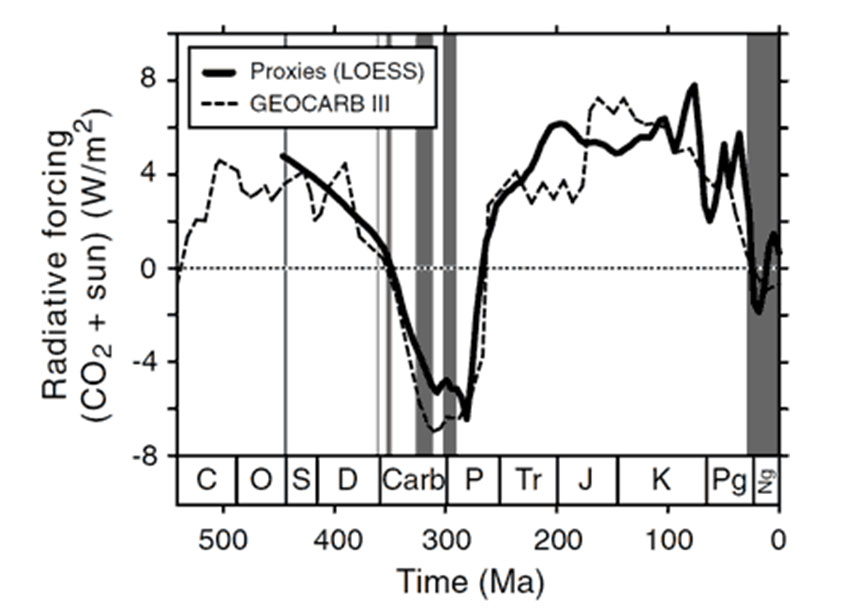
The Carbon Cycle and Ice Ages
Why are there Ice Ages? Will there be another one? In the following video with H.J. Schellnhuber this is explained:
The fast and slow carbon cycles maintain a relatively steady concentration of carbon in the atmosphere, land, plants, and ocean. But when anything changes the amount of carbon in one repository, the effect ripples through the others. In Earth’s deep past, the carbon cycle has changed in response to climate change many times.
As we have discussed, changes in Earth’s orbit alter the amount of energy Earth receives from the Sun and leads to a cycle of ice ages and warm periods like Earth’s current climate. Ice ages developed when Northern Hemisphere summers cooled and ice built up on land, which in turn slowed the carbon cycle. Meanwhile, a number of factors including cooler temperatures and increased phytoplankton growth may have increased the amount of carbon the ocean took out of the atmosphere. The drop in atmospheric carbon caused additional cooling. Similarly, at the end of the last Ice Age, 10,000 years ago, carbon dioxide in the atmosphere rose dramatically as temperatures warmed giving us the climate we have today.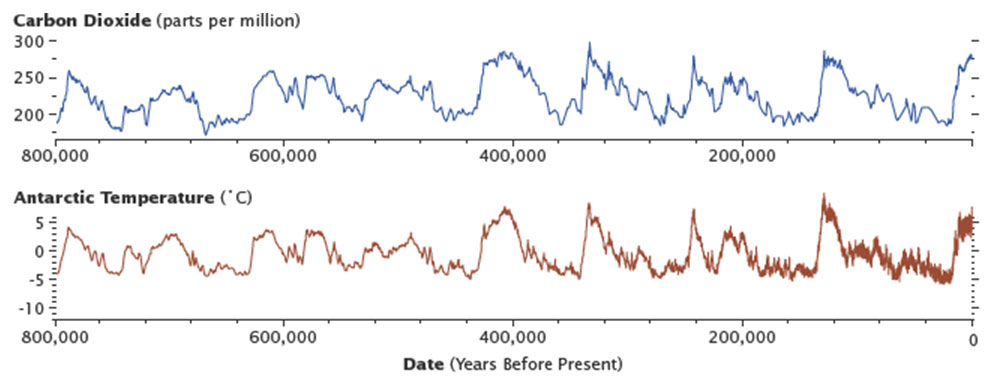
Shifts in Earth’s climate due to orbital fluctuations are happening constantly, in predictable cycles. In the deep past these shifts caused the great ice ages. Today, changes in the carbon cycle are happening because of people. We are disrupting the carbon cycle by burning fossil fuels and clearing land. We were expecting the next ice age in the next 50,000 years due to this cycle. However, H.J. Schellenhuber calculates, using geophysics exponential equations he calls simple, that we have even thrown off the next ice age.
‘The will be no ice age again. The human impact is so powerful already (that’s why they call it the Anthropocene), that we have suppressed the Quaternary planetary dynamics.’ – H.J. Schellenhuber
Even though it has become very popular for deniers to argue that the Earth is cooling and there is another ice age coming, this is not what objective, credible research tell us.
The Paleocene Eocene Thermal Maximum (PETM)
Paleoclimatology shows numerous instances in prehistory when CO2 rose suddenly and wiped out life in may places around the globe. The Paleocene Eocene Thermal Maximum (PETM) which occurred 56mya is often cited by scientists to show the direct causal relationship between CO2 and dangerous temperature rise. The last time CO2 levels were this high, the earth was uninhabitable. In this PBS EONS video the PETM is introduced:
This foundational paleoclimatology provides a clear picture of the causes of prior mass extinctions. The PETM is said to have been caused by a sudden spike in CO2, though what caused it is still under debate. It was thought to have come from the thawing of methane clathrates in deep ocean sediments, but the latest theory is that it was caused by a massive volcanic eruption that heated up coal deposits.
The PETM event resulted in one of the largest known extinctions of life forms in the deep ocean. Atmospheric temperatures increased by 5-8°C within a couple thousand years. The seas were a hot 23°C. The warming, which lasted 200,000 years, was caused by the release of massive amounts of methane or CO2. In other words, the PETM is an example of catastrophic global warming triggered by the build-up of greenhouse gases in the atmosphere.
The amount of carbon added to the atmosphere during this event varies between 2,000-10,000 billion tonnes of carbon according to reconstructions of this data. Although climate archives become less certain the further back we go, it is estimated that the carbon release must have been below 1.1 billion tons of carbon per year. That is quantified as about one-tenth of the rate of today’s carbon emissions from human activities such as burning fossil fuels; a cautionary tale if ever there was one.
What Might Survive a Greenhouse Gas Extinction Event?
The rate of release of carbon into the atmosphere today is nearly 10x as fast as during the Paleocene-Eocene Thermal Maximum (PETM), 55.9 million years ago, and again is the best analog we have for current global warming, according to an international team of geologists. Furthermore new studies (video) are showing we are already on track for at least a 3-5°C temperature rise. Dr. Neil Swart of the Canadian Center for Climate Modelling & Analysis says a new model predicts nearly 8°C of heating (video) by 2100 in a high emissions scenario.
These temperature increases are analogous to the PETM which provides some clues as to what the response of life to a warming world might be. Even the dinosaurs have something to teach us about global warming. Biological organisms cannot respond to the speed at which change is happening in our world today and this is already evident as 200 species a day are going extinct. The Earth is warming more and faster than it has since the end of the last Ice Age. The rate of change is now faster than in any of the previous 5 mass extinctions. So, what plants and animals will survive as temperatures continue to increase?
THREE RULES OF EXTINCTION
1) During warming, the most ecologically important species go first, not last.
2) Global warming drives more species to extinction faster than global cooling.
3) During warming, plants tend to go extinct first.
With one in every four species facing extinction, which animals are the best equipped to survive the climate crisis? (Spoiler alert: it’s probably not humans). – The Animals That WIll Survive Climate Change, BBC
Researchers are just beginning to make educated guesses about what will survive human-caused global warming and the sixth mass extinction. For example, heat tolerant and drought resistant plants, like those found in deserts rather than rainforests, are going to be more likely to survive. Further, the historical record points to the tenacity of cockroaches. These largely unloved critters “have survived every mass extinction event in history so far”, says Asmeret Asefaw Berhe, a soil biogeochemist at the University of California, Merced. For instance, cockroaches adapted to an increasingly arid Australia, tens of millions of years ago, by starting to burrow into soil.
The Holocene Warm and Cool Periods
Climate variability over the past 12,000 years has been caused by changes in external climate drivers, or internally generated by nonlinear dynamics and interactions among the different components of the climate system.
The climate of the Holocene really has been very stable, with temperatures only varying by a few degrees. The Holocene cold and warm periods, represent only small temperature changes compared to the glaciations and even to other interglacial periods. By contrast, the climate in the previous ice age was not nearly as stable and the temperature often varied more than 20°C during a few hundred years.
According to Bent Hansen on a History of the Earth’s Climate, “this unique climatic stability [during the Holocene] made the development of agriculture possible, it created the basis for the development of civilizations and enabled eventually the industrial revolution and consequently the modern world with its technique and myriads of people. Had we not had a window of about 10,000 years of stable climate with only small temperature variations, civilization would not have been nearly as developed, if at all existent, and Earth’s population would have been only a fraction of the current.”
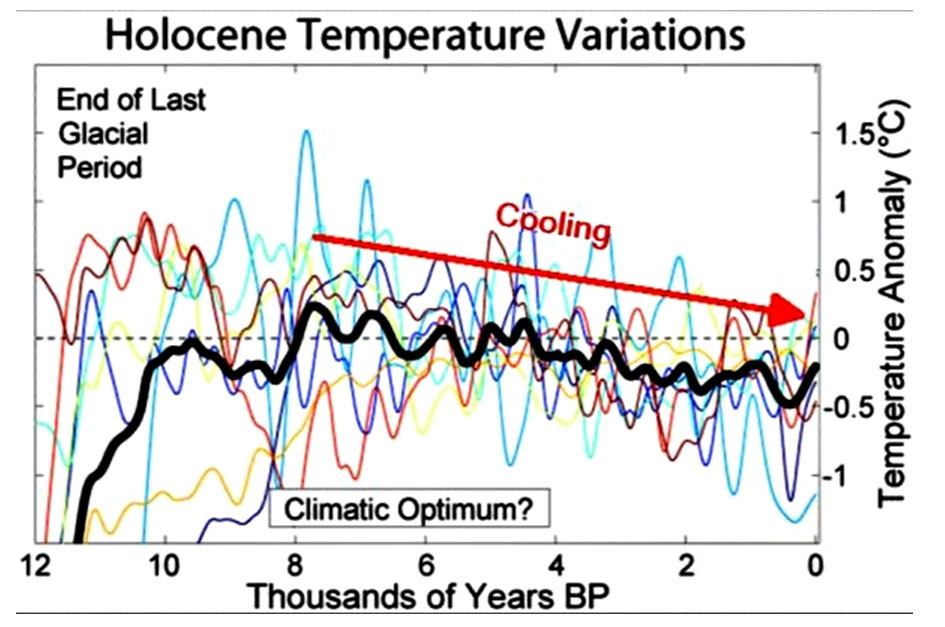
During the deglaciation that began later in the Holocene, the main external climate drivers were again the modulation of the orbital parameters of the Earth, change in the solar irradiance, volcanic activity, the concentration of GHGs in the atmosphere, astronomical conditions, thermal insulation. and changes in the properties of land cover – a bit of an unknown which is not widely discussed.
The hottest time in the Holocene occurred in the Stone Age about 8,000 years ago, is called the Holocene Maximum. Then there was also a mid-Holocene warm period about 6,000 years ago. This chart from the University of Arizona on this topic shows the distinct climatic periods of the Holocene.
According to Climate Change During the Holocene, “anthropogenic land-cover change (ALCC) is one of the few climate forcings for which the net direction of the climate response over the last two centuries is still not known. The uncertainty is due to the often counteracting temperature responses to the many biogeophysical effects and to the biogeochemical versus biogeophysical effects. Palaeoecological studies show that the major transformation of the landscape by anthropogenic activities in the southern zone of the Baltic Sea basin occurred between 6000 and 3000/2500 cal year BP.”
Finally, What Causes Climate Change According to the Paleorecord?
Now that we have taken in the big picture perspective we can begin to answer this question. We can see that The causes of climate change are quite complex. There are several major factors that can effect the climate system, including some of those reviewed here. To sum up these include:
- Aerosols
- Astronomical conditions
- Changes in solar output
- Changes in Earth’s orbit (Milankovitch Cycles)
- Changes in the distribution of continents and land cover
- Changes in atmospheric content of greenhouse gases (GHGs)
- C12/C13 Ratios
- Thermal insulation
- Volcanism
- Water Vapor
What is clear from the study of past climate is that many factors influence climate. There are many more factors than listed here as this is only the tip of the iceberg, as it were. This resource is meant as an introduction to some of these complexities. In addition, the details are seldom as simple as they seem at first glance. There are complex interactions between many of these factors that can amplify or dampen changes in temperature. Further study is always encouraged.
There are many complexities in the paleoclimate record that are often overlooked and/or relatively unknown. In this discussion we have listed several of them. It is worth noting that according to Tom Yulsman at Discover Magazine “researchers also never contended that CO2 is the sole factor driving climate changes over geologic history. As we’ve seen, however, it plays a key role: Without the CO2 thermostat, Earth would likely be a proverbial snowball.” We tend to focus on CO2 but the picture is actually much more complex. There are also differences in C12/C13 ratio impacts. This is not nearly as straightforward as it may ostensibly seem and journalists, large corporations and politicians speaking on these matters are usually not in the know on these matters like scientists.
In short, the fact that it has been warmer in the past does not mean that future warming is nothing to worry about. The sea level has been tens of meters higher during past warm periods in our deep history, enough to submerge most major cities around the world. Temperatures were much higher than our current perfect 14°C world. There were no humans on the planet during these times. It was quite literally a different world.
Interpreting the Past to See into the Future
There are many lessons and takeaways in the deep past that continue to enhance our big picture perspective. According to LiveScience, “when the simple math of the modern Keeling Curve is added to atmospheric research from the past, it shows a trend that has alarmed scientists worldwide: CO2 levels are rising at a dramatic pitch, one unseen in the entire geologic record.”

This graph shows a steep increase in CO2 and temperatures going quite literally off the charts. This is unprecedented. Therefore, even though the paleoclimate record has provided us with many key insights, we are reminded that in this case our knowledge of the past may be insufficient to fully comprehend the anthropogenic factors we are adding to this complex system in ways never seen before in the history of the planet. We are in uncharted territory.
Understanding this deep history has clearly aided in establishing evidence for the causal relationship between CO2 and AGT (average global temperatures) even though 30+ years later deniers still lie about these facts as well as the simple physics behind these models. In modern times, we cannot forget that there is a 97% scientific consensus on this causal relationship as more recent decades have provided us with indisputable evidence.
We have recently entered the sixth mass extinction. In this case, human industrial activity especially the burning of fossil fuels, has become comparable to the volcanism of our distant past. Recent data indicates that we are now at 409+ ppm CO2. This figure has shot up very quickly in terms of geological time scales. In fact, it is unprecedented even in the oldest paleontology records.
In 1988, James Hansen famously presented evidence to Congress, testifying that the climate sensitivity is about 3°C for a doubling of atmospheric CO2. We are now getting closer and and closer to doing just that. The last time CO2 was this high there were no humans on the planet. Further, according to NRDC, “during our 200,000-or-so years on this planet, CO2 concentrations have largely stayed below 300 ppm, as ice cores prove. For humans, this is uncharted territory.”
“In past warming events, atmospheric CO2 rose too fast for many species to adapt. Today it is rising 10 times faster than at any time in 66 million years. In the past, rapid increases in greenhouse gases have been associated with mass extinctions. It is therefore important to understand how unusual the current rate of atmospheric CO2 increase is with respect to past climate variability. With increasing CO2 levels, temperatures and ocean acidification also rise, and it is an open question how ecosystems are going to cope under such rapid change.” – Katrin Meissner
Further, Peter Ward states “we already have 3 feet of sea level rise baked in” given our current emissions trajectory. CO2 concentrations take decades to reduce. Additionally, H.J. Schellenhuber says in the video provided above that we have even thrown off the entire Quaternary procession. The Arctic ocean is in a death spiral toward the first blue ocean event, and Greenland is right behind it. We have already passed 4 of the 9 planetary boundaries. Additionally, the 3 feet of sea level rise researchers are now expecting due to anthropogenic climate forcings in the modern era will displace millions of people in coastal cities around the world.
The evidence now conclusively shows us that large planetary boundary disruptions are already in place due to human activity. This means that even if we stop fossil fuel emissions today, we are already too late to stop the seas rising unpredictably into the next decades from 3 to as much as 6 feet according to some estimates. Thus, we are already literally in over our heads with the climate changes predicted in many places around the globe as global warming repeats itself (video) as it has many times before in history.

However, according to eminent climate scientist and paleoclimatologist Michael Mann “‘we can still prevent many of the worst impacts of climate change from playing out.” In this video Michael Mann looks Into our climate past to interpret our climate future. Michael Mann’s Hockey Stick Model presents climate data for the last millennium. The methods used in reconstructions of the temperature record of the past 1000 years have been disputed. However, reconstructions have consistently shown that the rise in the instrumental temperature record of the past 150 years is not matched in earlier centuries, and the name “hockey stick graph” was coined for figures showing a long-term decline followed by an abrupt rise in temperatures.
This is a nothing short of an invisible crisis; one we often ignore because it is not visible to us over such vast time scales. In short, It’s clear that we simply cannot continue with business as usual (BAU) and even though the picture is bleak, we must take care to prompt action, not paralysis. “There’s still time to make the right choices” says Michael Mann (video).
Learn More:
- Climate Change and Paleoclimatology (video) | UCANR
- Climate Proxies: What We Know, How We Know, and How to Communicate It (video) | UCAR/NCAR
- Fingerprinting Climate Using Proxies (video) | Dr. Jeremy Owens | TEDxFSU
- Global Climate Change from 1870-2100 (video| UCAR
- Global Climate Change: Paleoclimate (video) | Green Ninja
- Uncovering the History of the Earth’s Climate (video) | PBS
__________________________________________________________________
References:
- Borzenkova et al. (2015). Climate change during the Holocene. https://link.springer.com/chapter/10.1007/978-3-319-16006-1_2
- Hansen, Bent (2019). History of earth’s climate (Chapter 7). Retrieved from: http://www.dandebat.dk/eng-klima7.htm
- Mann, Michael (2011). A look into our climate: past To present To future. Retrieved from https://www.youtube.com/watch?v=ElI-XVGHCHs
- Meissner, Katrin (2018). Climate change vs biodiversity. Retrieved from https://climateandcapitalism.com/2018/10/23/greenhouse-gases-and-mass-extinctions-speed-kills/
- Nature (2018). Trajectories of the Earth system in the Anthropocene. Retrieved from https://www.pnas.org/content/115/33/8252
- New Scientist (2007). Climate myths: its been far warmer in the past, what’s the big deal? Retrieved from https://www.newscientist.com/article/dn11647-climate-myths-its-been-far-warmer-in-the-past-whats-the-big-deal/
- PBS Eons (2017). The last time the globe warmed, the PETM. Retrieved from https://www.youtube.com/watch?v=ldLBoErAhz4
- Planet Experts (2019). The smoking gun of global warming. Retrieved from http://www.planetexperts.com/smoking-gun-global-warming/
- Schellenhuber, H.J. (2018). Actual Expert tells audience, we won’t have an Ice Age again! Retrieved from https://www.youtube.com/watch?v=HyWSMovZLVY&t=1418s
- Skeptical Science (2019). Do high levels of CO2 in the past contradict the warming effect of CO2? Retrieved from https://www.skepticalscience.com/co2-higher-in-past-intermediate.htm
- Skeptical Science (2019). Climate change cluedo. Retrieved from https://www.skepticalscience.com/anthrocarbon-brief.html
- Ward, Peter (2013). Our future In a world without ice caps. Retrieved from https://www.youtube.com/watch?v=HtHlsUDVVy0
__________________________________________________________________
Last Updated: 06/19/2021



